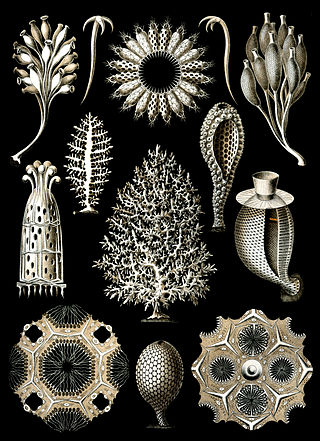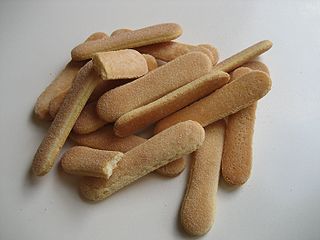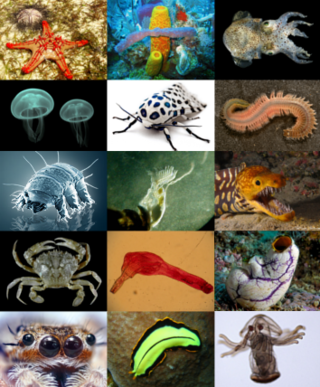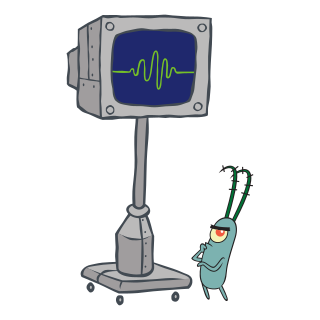
Sponges or sea sponges are primarily marine invertebrates of the metazoan phylum Porifera, a basal animal clade and a sister taxon of the diploblasts. They are sessile filter feeders that are bound to the seabed, and are one of the most ancient members of macrobenthos, with many historical species being important reef-building organisms.

Hexactinellid sponges are sponges with a skeleton made of four- and/or six-pointed siliceous spicules, often referred to as glass sponges. They are usually classified along with other sponges in the phylum Porifera, but some researchers consider them sufficiently distinct to deserve their own phylum, Symplasma. Some experts believe glass sponges are the longest-lived animals on earth; these scientists tentatively estimate a maximum age of up to 15,000 years.

Cake is a flour confection made from flour, sugar, and other ingredients and is usually baked. In their oldest forms, cakes were modifications of bread, but cakes now cover a wide range of preparations that can be simple or elaborate and which share features with desserts such as pastries, meringues, custards, and pies.

SpongeBob SquarePants is a fictional character and the protagonist of Nickelodeon's eponymous American animated television series. Voiced by Tom Kenny, he is characterized by his optimism and childlike attitude. SpongeBob is a denizen of Bikini Bottom, where he regularly gets into absurd and humorous scenarios.

In mathematics, the Menger sponge is a fractal curve. It is a three-dimensional generalization of the one-dimensional Cantor set and two-dimensional Sierpinski carpet. It was first described by Karl Menger in 1926, in his studies of the concept of topological dimension.

Mrs. Penelope "Poppy" Puff is a fictional character in the Nickelodeon animated television series SpongeBob SquarePants and all three films based on the franchise. Voiced by Mary Jo Catlett, Mrs. Puff debuted in the season one episode "Boating School" on August 7, 1999. Mrs. Puff was created and designed by marine biologist and animator Stephen Hillenburg. He developed the character in response to a request from Nickelodeon that the show star a schoolteacher. Hillenburg did not want to portray SpongeBob as a school-age child, so Mrs. Puff was introduced as his driving instructor instead of an elementary school teacher.

Sandy Cheeks is a fictional character in the American animated comedy television series SpongeBob SquarePants and the Nickelodeon franchise of the same name. She is voiced by Carolyn Lawrence and first appeared in the episode "Tea at the Treedome", which premiered on May 1, 1999. She was created and designed by marine biologist and animator Stephen Hillenburg who is also the creator of the series. Sandy is portrayed as an intelligent anthropomorphic flying squirrel who wears an astronaut-like diving suit and lives underwater.

The calcareoussponges are members of the animal phylum Porifera, the cellular sponges. They are characterized by spicules made of calcium carbonate, in the form of high-magnesium calcite or aragonite. While the spicules in most species are triradiate, some species may possess two- or four-pointed spicules. Unlike other sponges, calcareans lack microscleres, tiny spicules which reinforce the flesh. In addition, their spicules develop from the outside-in, mineralizing within a hollow organic sheath.

The contraceptive sponge combines barrier and spermicidal methods to prevent conception. Sponges work in two ways. First, the sponge is inserted into the vagina, so it can cover the cervix and prevent any sperm from entering the uterus. Secondly, the sponge contains spermicide.

Ladyfingers or Naples biscuits, in British English sponge fingers, also known by the Italian name savoiardi or by the French name boudoirs, are low-density, dry, egg-based, sweet sponge cake biscuits roughly shaped like large fingers. They are a principal ingredient in many dessert recipes, such as trifles and charlottes, and are also used as fruit or chocolate gateau linings, and for the sponge element of tiramisu. They are typically soaked in a sugar syrup or liqueur, or in espresso for tiramisu.

Stephen McDannell Hillenburg was an American animator, voice actor, and marine biology teacher, best known for creating the animated television series SpongeBob SquarePants for Nickelodeon in 1999. Serving as the showrunner for its first three seasons, and again from season nine until his death, the show has become the fifth-longest-running American animated series. He also provided the original voice of Patchy the Pirate's pet, Potty the Parrot.

Demosponges (Demospongiae) are the most diverse class in the phylum Porifera. They include greater than 90% of all species of sponges with nearly 8,800 species worldwide. They are sponges with a soft body that covers a hard, often massive skeleton made of calcium carbonate, either aragonite or calcite. They are predominantly leuconoid in structure. Their "skeletons" are made of spicules consisting of fibers of the protein spongin, the mineral silica, or both. Where spicules of silica are present, they have a different shape from those in the otherwise similar glass sponges. Some species, in particular from the Antarctic, obtain the silica for spicule building from the ingestion of siliceous diatoms.

SpongeBob SquarePants is an American animated television series created by marine science educator and animator Stephen Hillenburg for Nickelodeon. It first aired as a sneak peek after the 1999 Kids' Choice Awards on May 1, 1999, and officially premiered on July 17, 1999. It chronicles the adventures of SpongeBob SquarePants and his aquatic friends in the underwater city of Bikini Bottom.

Animals are multicellular, eukaryotic organisms in the biological kingdom Animalia. With few exceptions, animals consume organic material, breathe oxygen, have myocytes and are able to move, can reproduce sexually, and grow from a hollow sphere of cells, the blastula, during embryonic development. Animals form a clade, meaning that they arose from a single common ancestor. Over 1.5 million living animal species have been described, of which around 1.05 million are insects, over 85,000 are molluscs, and around 65,000 are vertebrates. It has been estimated there are as many as 7.77 million animal species on Earth. Animal body lengths range from 8.5 μm (0.00033 in) to 33.6 m (110 ft). They have complex ecologies and interactions with each other and their environments, forming intricate food webs. The scientific study of animals is known as zoology, and the study of animal behaviour is known as ethology.
The sponge and dough method is a two-step bread making process: in the first step a sponge is made and allowed to ferment for a period of time, and in the second step the sponge is added to the final dough's ingredients, creating the total formula. In this usage, synonyms for sponge are yeast starter or yeast pre-ferment. In French baking the sponge and dough method is known as levain-levure. The method is reminiscent of the sourdough or levain methods; however, the sponge is made from all fresh ingredients prior to being used in the final dough.

Sponge diving is underwater diving to collect soft natural sponges for human use.

Sponge cake is a light cake made with eggs, flour and sugar, sometimes leavened with baking powder. Some sponge cakes do not contain egg yolks, like angel food cake, but most of them do. Sponge cakes, leavened with beaten eggs, originated during the Renaissance, possibly in Spain. The sponge cake is thought to be one of the first non-yeasted cakes, and the earliest attested sponge cake recipe in English is found in a book by the British poet Gervase Markham, The English Huswife, Containing the Inward and Outward Virtues Which Ought to Be in a Complete Woman (1615). Still, the cake was much more like a cracker: thin and crispy. Sponge cakes became the cake recognised today when bakers started using beaten eggs as a rising agent in the mid-18th century. The Victorian creation of baking powder by British food manufacturer Alfred Bird in 1843 allowed the addition of butter to the traditional sponge recipe, resulting in the creation of the Victoria sponge. Cakes are available in many flavours and have many recipes as well. Sponge cakes have become snack cakes via the Twinkie.

Patrick Star is a fictional character in the American animated television series SpongeBob SquarePants. He is voiced by actor Bill Fagerbakke and was created and designed by marine biologist and animator Stephen Hillenburg. He first appeared in the series' pilot episode "Help Wanted" on May 1, 1999. In addition to his supporting role on SpongeBob SquarePants, Patrick also serves as the main protagonist of The Patrick Star Show, which premiered in 2021.

Sheldon J. Plankton and Karen Plankton are a pair of fictional characters and the main antagonists of SpongeBob SquarePants, the Nickelodeon animated television series. They are voiced by Mr. Lawrence and Jill Talley, respectively. Their first appearance was in the episode "Plankton!", which premiered on July 31, 1999. They were created and designed by the marine biologist and animator Stephen Hillenburg, the creator of the series. Hillenburg named Karen after his wife, Karen Hillenburg.

















